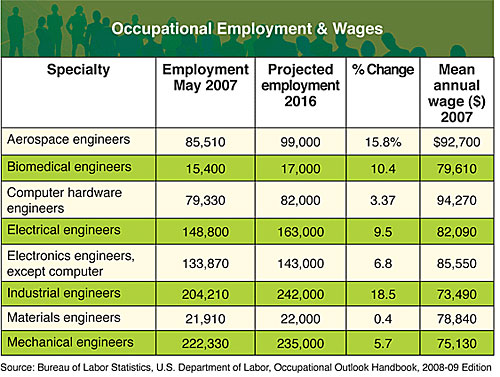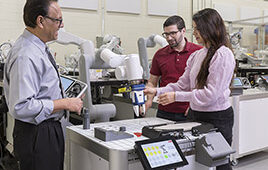The job outlook for some engineering disciplines may be uncertain, but taking key steps to broaden your skills can help you hold onto your current job or find a new one.
When the Bureau of Labor Statistics, U.S. Department of Labor, published its Occupational Outlook Handbook, 2008-09 Edition earlier this year, it predicted that on average, for all engineering disciplines, the overall employment change would grow by 11% by 2016. However, significant changes in government, consumer, and business spending could undercut it or alter which industries fuel the growth.

Engineers already familiar with designing, testing, and building by using simulation software will have an advantage over others heading into an uncertain job market.
Today’s economic uncertainty makes it difficult to predict what the job market will look like from one day to the next, but one fact remains constant: the further you diversify your knowledge and skills, the more you increase your chances of finding and maintaining a job. If you are up-to-date with new technology and have a broad knowledgebase, you can more easily adapt to the changing needs of the marketplace and those of your company.
Job outlook
The demand for aerospace engineers is expected to increase considerably more than for computer, electrical, electronics, mechanical, and materials engineers because the market is demanding a new generation of commercial aircraft to replace old fleets. Earlier this year, experts predicted that new fixed-wing aircraft, such as Very Light Jets (VLJs), as well as composite aircraft would soon change the way people travel. However, as the global recession worsens and credit tightens, many experts worry that new aircraft development will suffer.
Engineers should particularly be watchful, as there often is a delay before companies’ cutbacks are reflected in carriers’ finances. By focusing on fundamental technical concepts, as well as diversifying their experience, they can keep their options open in the event they need to change careers should further cutbacks occur. The Bureau of Labor Statistics, however, indicated that increases in the number and scope of military aerospace projects would generate jobs in this field significantly through 2016, which would create a demand for more aerospace engineers.
Demand for electrical devices as well as an increase in the demand for personal computers in developing nations is strong, but as companies continue to move high-skill engineering jobs overseas, employment growth for electrical, electronics, and computer hardware engineers will remain down. Offshoring has discouraged many college students from pursuing degrees in these fields, which lowers competition slightly by reducing the number of new graduates. “Growth is expected to be fastest in service-providing industries–particularly in firms that provide engineering and design services,” says the Bureau of Labor Statistics. Electrical and electronics engineers who work in firms that provide engineering expertise and design services should have better job opportunities.
The good news
The Bureau of Labor Statistics says that the need for technological advancements will keep employment opportunities open because companies must improve and update product designs and make their manufacturing processes more efficient. Engineers will still be needed on-site in various capacities to increase productivity and expand the output of goods and services. Most of the opportunities for employment across all disciplines will come from a need to replace engineers who retire, transfer to management, sales, or other occupations, or leave engineering for other reasons, the Occupational Outlook for 2008-09 indicates.
How to keep your options open
Take steps to gain knowledge and experience in more than one specialty or job function. Employers want candidates who can meet multiple responsibilities and adapt to changing demands. And when jobs are in short supply, the more well rounded your knowledgebase is, the more equipped you are to shift to fields with better employment prospects. For example, mechanical engineers have a slower than average projected employment growth over the next decade at 4%, because the majority of mechanical engineers are employed in the manufacturing industries, where growth is expected to decline. But according to the Bureau of Labor Statistics, mechanical engineers have an advantage over engineers in other fields. In a tight job market, they can readily apply the skills they acquire from their study of a more diverse curriculum to other engineering specialties.

The most job growth is expected to occur in the industrial, aerospace, and biomedical engineering fields. Materials engineers will see little job growth, except those specializing in nanomaterials and biomaterials.
Stay current in your field. When layoffs occur, engineers who have not kept current in their field are the first to lose their jobs. They may also miss opportunities for promotions. But just because you have solid technical skills, you are not immune from losing your job. And technical skills alone will not always land you a new job. The best way to protect yourself from an employment crisis is to become technically well rounded and improve your business skills. If you can, take some classes at a local school or study on your own.

In 2006, almost half of computer hardware engineers worked in computer and electronic product manufacturing. By 2016, as these positions are offshored, job growth is expected to occur in engineering services-related industries.
Keeping your engineering skills up-to-date and career on track requires constant learning says COMSOL. The company’s modeling software, COMSOL Multiphysics®, is used in many colleges and universities to teach multiphysics phenomena and the practical applications of partial differential equations (PDEs). Professor Ernesto Gutierrez-Miravete, Department of Engineering Science, Rensselaer at Hartford Polytechnic Institute, who implements the program in his classes, sees many engineers returning to school for further education. Most of his students are practicing engineers seeking a degree, with an average of five to seven years of experience in the field. A significant number of older engineers also attend the institute. The majority of Gutierrez-Miravete’s students are seeking a management degree, but some are working towards a second engineering degree to add to their skill-sets.

COMSOL Multiphysics is used to design and analyze a hip-replacement assembly in a biomedical finite-element course that incorporates not only structural aspects but also thermal, electromagnetic, and other physics. It promotes a new interdisciplinary approach to educating future engineers.
Education is changing
Most engineering graduates receive their degrees in one discipline-most commonly electrical, electronics, mechanical, or civil engineering. They do not often receive dual degrees in say, electrical and mechanical engineering. However, training in one branch often lets you work in related branches. According to top engineering schools, today’s new graduates have a significant advantage because the curriculum is more broad-based than it has been in the past. A degree in engineering prepares students for careers in many fields, should they decide to switch later in life. Expanded curriculums are increasingly being offered to students majoring in fields outside of mechanical engineering.
What’s more, more schools are moving beyond the traditional classroom lecture in favor of a “design-build-test” model, as COMSOL explains. Associate Professor Gutierrez-Miravete introduces his first-year students to partial differential equations (PDEs) using finite-element analysis (FEA) to motivate them to master concepts that they will later study in detail. Among the many advantages is that the classroom mimics the challenges they will encounter both on the job and in their career search. According to COMSOL, students learn by encountering problems, making mistakes, and overcoming them. Even older students returning to school can benefit.
Bureau of Labor Statistics,
U.S. Department of Labor
www.bls.gov/oco/ocos027.htm
COMSOL
www.comsol.com/academic
::Design World::
Filed Under: Commentaries • insights • Technical thinking, Student programs





Tell Us What You Think!